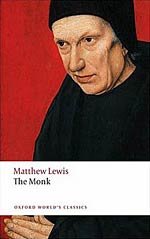
![]() verkisto
verkisto
7/26/2016
![]()
The Monk is one of those books I've known about for years. Stephen King wrote about it in Danse Macabre, and even wrote an introduction for a modern printing of the book, but the age of the book deterred me from reading it, since I figured it would be difficult to parse a narrative style that was written 220 years ago. I suffered flashbacks from my English classes where I would read dozens of pages without comprehending much of what was being said to me. Luckily, twenty years of reading has helped me learn the trick to understanding these books.
The structure of the story is troublesome. It starts off fine, with Lewis introducing us to Ambrosio, the pious and respected monk, and then Rosario, a young boy who lives at the monastery, but once we settle into those two characters, Lewis takes us off on a tangent relating to a secondary character we met in the first chapter. That tangent (two chapters; about a quarter of the book's length) is important to the story, but it was awkwardly constructed. Looking back, I'm not sure if I could think of a better way to structure the story, but I almost lost the book all together during that tangent. Later, there were several pages devoted to a poem, and one of the characters' response to it, where he goes off on a tirade about the troubles of a writer's life. Maybe Lewis wanted to express his opinion through the characters? I guess?
Regardless, the meanderings (save for the bit about writing) are relevant to the story, not just in establishing character, but also establishing tone. In that tangent, we get our first glimpse of the supernatural, with the story of the Bleeding Nun and an appearance by the Wandering Jew, which helps us recognize the portents of the supernatural later in the story. It also
The book has a reputation for its lurid perversions, which affected my expectations for the book. It took a long time for those perversions to present themselves (not that I was reading it to be titillated), and then when they did (which seemed later in the story than expected), they seemed less lurid to me than I was led to believe. I understand that two hundred years ago modesty was more pronounced, and that this was likely shocking in how it presented Ambrosio's fall, but after having read authors like Edward Lee and Jack Ketchum, "lurid" takes on a whole new meaning.
That being said, I think the story is better for having a slower build up to the corruption. The story is all about Ambrosio's fall from grace, and Lewis gives us reasons for why he fell. He establishes his character as flawed, even if Lewis reveal the reasons after Ambrosio commits his perversions, though it all boils down to him lusting after women. Lewis throws in a couple of criticisms of the church along the way (which would be hard to avoid, considering the whole point of the novel is to show the fall of a religious figure), but in the end he reveals that Ambrosio's fall, while done strictly of his own will, is due to being tempted by the devil. It almost removes Ambrosio's responsibilities for committing his acts (the gravity of some of his atrocities isn't even known to him until the final chapter), and it lessens the impact of the story on me.
Lewis' introduction of Rosario/Matilda reminds me a little of how Piers Anthony portrays Lilith in For Love of Evil. She corrupts Parry through sex, setting him up to take on the Incarnation of Evil. Matilda, at first, is more innocent, and Lewis doesn't portray her as someone who is out to corrupt Ambrosio, but there's still something about how she approaches him and how he descends into perversion with her that makes me wonder if Anthony used this book as a model for his own characters.
Curiously, the introduction, by E.A. Baker and written for the 1906 reprint, is full of backhanded compliments. He writes that all of Lewis' contemporaries and literary descendants created far better works than Lewis did, but comes back to praise Lewis for being the one to popularize the lurid. In a way, it reminds me of how splatterpunk is received against more subtle forms of horror, but it was odd to read such criticism in the introduction. On the bright side, the introduction mentioned plenty of other early Gothic tales to add to my reading list.
Another introduction, written by Stephen King, gives us a much more appreciative view of the novel. It's not in the pictured edition, so I tracked it down and read it, too. I'd recommend finding an edition with King's introduction, since it gives us a bit more history and context into what made The Monk such a popular and lasting book. I'd also recommend reading it last, especially if you haven't read the novel before, since King spoils a few key elements of the story.
I was surprised to find that I like this book as much as I do. I don't think it's perfect, but it holds up pretty well, considering its age.